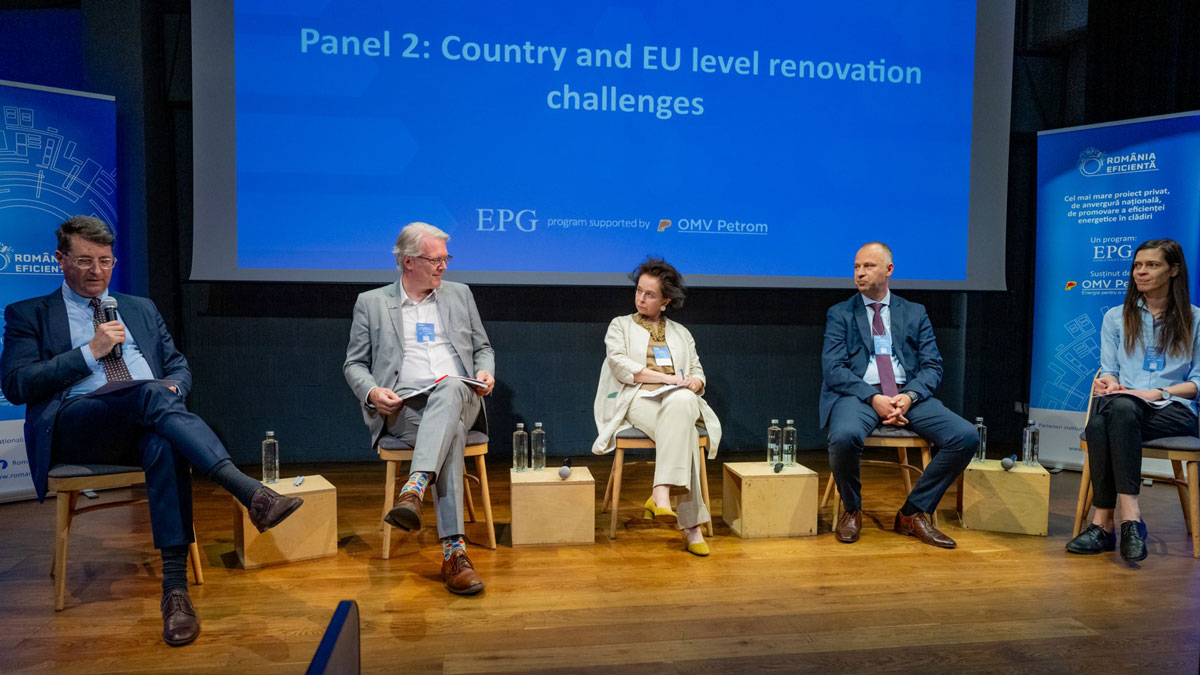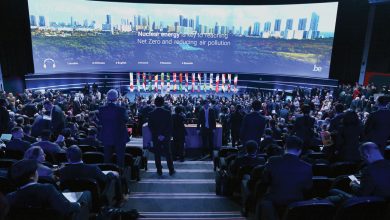Romania Eficienta Forum 2024: Energy Efficiency and Decarbonisation of Buildings
The latest review of the Energy Performance of Buildings Directive (EPBD) sets ambitious objectives to reduce global consumption of energy of the European Union buildings and establishes the common framework for the Member States to rely on for the reduction of carbon emissions and energy efficiency, according to the national particularities.
Th experts attending the fifth edition of the Romania Eficienta Forum on “EPBD Recast. Policy, challenges, and implementation” have discussed about the key changes introduced by the revision of EPBD and their impacts at national and regional level. ZEB concept and carbon and greenhouse gas indicators throughout the life cycle of buildings, as well as the tools and measures provided for the extension of the renovation of the building stock have been identified as critical elements in achieving climate neutrality objective.
“We believe deeply in the concept of energy efficiency”, Christina Verchere, CEO OMV Petrom said at the opening of the event, and its application in one of the most important sectors, that of buildings, is the foundation of the partnership with Energy Policy Group and of the Romania Eficienta program. Speeding up the pace of building renovation entails to transcend from individual projects to a global-wise sustainable transformation, and “one of our objectives was and remains to prove that it is possible to offer models that can be replicated”, she added, referring to the nZEB standard renovation of public educational establishments selected at national level, under the Romania Eficienta program.
“It is an honour for me to deliver the first presentation of the Energy Performance of Buildings Directive in Bucharest, after the official adoption. In its current version, EPBD is the fruit of a democratic process started in 2021 with the European Commission proposal, and of the negotiations with the co-workers from the European Parliament and Council,” stressed the special guest of the conference, Bogdan Atanasiu, the European Commission representative, at the onset of his detailed analysis of how the EPBD’s revision supports the achievement of climate neutrality of the buildings sector in the medium- (2030) and long-term (2050).
Zero Emissions Buildings: ZEB Concept
The presentation delivered by Bogdan Atanasiu was followed by the first panel of the conference focused on the importance of setting robust and coherent regulations, standardised at the level of the European Union, starting from the ZEB concept, and transposing them into the national legislation.
Oana Ozmen, Secretary of the Industry and Services Commission, Chamber of Deputies, declared: “We should encourage both the public sector and the investors to capitalise on the opportunity of the energy efficiency of buildings. It is also important to encourage the use of green building materials and access to new accessible technologies.”
OAER President Catalin Lungu advises on the introduction of the requirements related to the buildings’ emissions in the definition of the ZEB concept: zero fossil fuels emissions and zero or very low operational greenhouse gas (GHG) emissions. Energy efficiency and decarbonisation are the two major objectives of the EPBD, and differentiating between indicators such as global warming potential over throughout the life cycle of buildings and greenhouse gas emissions over the entire life cycle of buildings is very important from a technical perspective. “The objective is not to only reduce the consumed energy but also the carbon and greenhouse gas emissions,” he mentioned.
Transition to ZEB buildings is, according to the President of pRO-nZEB Cluster Horia Petran, an additional step towards achieving the climate objectives, that complement the efficiency of energy consumption, according to the nZEB standard, reducing emissions by the use of renewable energy sources. “The time has indeed come to discuss about ZEB, but we should not lose sight of our current obligation, the nZEB buildings”, he mentioned.
Challenges to the implementation of a new wave of renovations at National and European level
In the context of the extremely low rate of building renovation in Romania, the second panel of the conference dived, based on the complementary perspectives of the specialist guests, on the possible strategies and measures that the EPBD provides to overcome the hurdles in this sector.
Therefore, according to the new Energy Performance of Buildings Directive, the EU Member States’ National Long-Term Building Renovation Strategies will be replaced by National Building Renovation Plans, which should be coordinated with the Integrated National Energy and Climate Change Plans. The Member States have the obligation to introduce support measures and ensure the financing necessary to implement these Plans.
“Long-term planning is crucial and detailing renovation plans using, where appropriate, the concept of deep renovation or staged deep renovation will allow monitoring of implementation,” the Secretary General EFIEES Valérie Plainemaison said.
In this respect, it is also noted the obligation to set up national databases/registers on energy efficiency in buildings and to report progress, at least annually, to the Building Stock Observatory of the European Commission.
“Monitoring the implementation of energy efficiency policies of buildings has been very difficult so far, we had to rely on estimates resulting from indirect studies”, explained Bogdan Atanasiu.
In order to align the building stock with EU standards, the challenge of underperforming renovations must also be overcome, as a result of which buildings do not meet the estimated energy performance standard. This issue is addressed by a new project initiated by EPG in collaboration with partners from Bulgaria, Croatia, and Poland. The main objectives of the OUR-CEE project (Overcoming Underperforming Renovations in Central and Eastern Europe), presented by Aura Oancea, researcher and EPG representative, are to improve awareness and information, at institutional level, on underperforming renovations of public buildings and to promote the increase of energy efficiency of these buildings through additional works, based on clear roadmaps.
ROENEF Manager Mihai Moia also identified challenges in terms of the institutional capacity of the Romanian authorities: different central authorities manage different aspects of energy efficiency in buildings, and their actions need to be more cooperative and coherent.
From the perspective of the authorities, consultative dialogues with the representatives of the private and academic sector and non-profit organisations in the field of energy are very important in the processes of harmonisation of national legislation with the European one and establishment and implementation of public policies.
“Implementation of the energy efficiency policies builds on the partnership and cooperation of the public sector with the private one and on the implication of the energy specialists,” Anca Ginavar, Director, Ministry of Development, Public Works and Administration, highlighted.
National building renovation plans should be subject to negotiations between all political parties, in order to ensure their implementation in the medium and long run, regardless of the results of elections, added Adrian Joyce, Renovate Europe Manager.
Embedded Carbon Emissions
Decarbonisation of the building material sector was the theme of the third panel of the Romania Eficienta Forum, with a focus on the role of introducing the methodology for assessing environmental effects throughout the life cycle of products – LCA (Life Cycle Assessment) and the GWP indicator, which measures their global warming potential.
A mentality shift is, however, necessary, on how we build, by transitioning from traditional constructions, which mainly use materials such as concrete, steel and masonry, to lightweight constructions, based on alternative materials that offer the same performance, with a much lower carbon footprint. An important tool in this context is the Environmental Product Declaration (EPD), the environmental performance report that takes into account environmental impact throughout their entire life cycle.
“Declaring the global warming potential (GWP) of products will become mandatory in a few years, and our society is not ready for this instance,” said Raluca Petrescu, Strategy, Sustainability and Public Advocacy Director at Saint-Gobain Romania. The company she represents has already developed EPDs for almost 90% of the products sold, although this type of assessment is carried out strictly voluntarily by manufacturers at this stage.
However, the objective of building decarbonisation does not affect exclusively the construction sector, but the entire European economy, said Radu Dudau, EPG President and coordinator of the Efficient Romania programme. “Quality materials have a low carbon footprint, but their cost is also higher. We need to develop the economy to have a market that can integrate these products in a competitive manner, and European and national legislation have a critical role in this.”
About Romania Eficienta
Romania Eficienta is a nation-wide private project carried out by Energy Policy Group (EPG) in partnership and with funding from OMV Petrom. The project started in the summer of 2019 and consists of carrying out a national program for the promotion of energy efficiency. Romania Eficienta aims to support achieving Romania’s targets for 2030 in terms of reducing carbon emissions and increasing energy efficiency, both through information and education campaigns, and by carrying out concrete major renovation projects in public schools in different regions of the country. More details can be found on the website romania-eficienta.ro.
About Energy Policy Group
Energy Policy Group (EPG) is an independent, non-profit think-tank specializing in energy and climate policy, market analysis and energy strategy, founded in 2014. EPG contributes to a technologically advanced, sustainable, and socially acceptable energy system. EPG also promotes long-term decarbonization policies and measures in all economic sectors: energy, buildings, transport, industry, agriculture.
About OMV Petrom
OMV Petrom is the largest integrated energy producer in Southeastern Europe, with an annual Group hydrocarbon production of approximately 41 million boe in 2023. The Group has a refining capacity of 4.5 million tons annually and operates an 860 MW high-efficiency gas-fired power plant. The Group is present on the oil products retail market in Romania and neighbouring countries through approximately 780 filling stations under two brands – OMV and Petrom.
OMV Petrom is a company in which, as of end-2023, Romanian shareholders hold over 43% of the shares (of which the Romanian state, through the Ministry of Energy, holds 20.7%, and 22.5% are owned by pension funds in Romania, to which are added almost 500,000 individual investors and other Romanian entities). OMV Aktiengesellschaft, one of the largest listed industrial companies in Austria, holds a 51.2% stake in OMV Petrom, and the remaining 5.6% are held by other foreign investors. Of the total shares of OMV Petrom, 28.1% represents the free float on the Bucharest Stock Exchange.
OMV Petrom is one of the largest contributors to the state budget, with approximately EUR 42 billion in taxes and dividends paid between 2005 and 2023. During the same period, the company invested approximately EUR 18 billion.
Since 2007, OMV Petrom has included corporate responsibility principles into its business strategy. Between 2007 and 2023, the company has allocated around EUR 160 million to develop communities in Romania, focusing on environmental protection, education, health, and local development.
On 29 July 2020, OMV Petrom announced its support for the recommendations issued by the Task Force on Climate-related Financial Disclosures (TCFD) regarding risks and opportunities on climate change. OMV Petrom annually reports on the progress made in implementing these recommendations.







